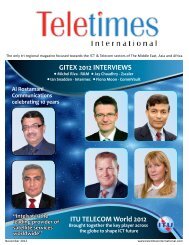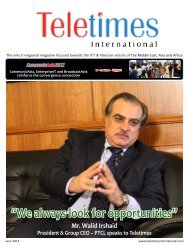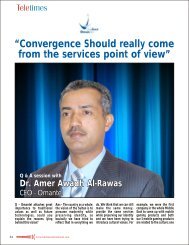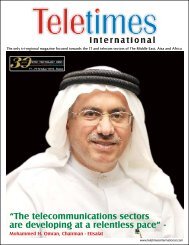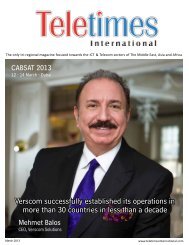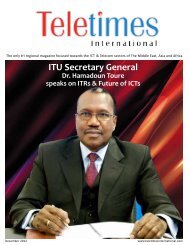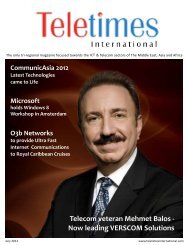tion have been designed to doexactly this and have been developedto grow with operatorschanging needs while negatingthe need to upgrade hardwarebefore its useful operationalcycle has run out.TT - Would you please elaborateon Traffic managementsolutions of your company?MB - The massive growthin data traffic as well as theability to monetize this trafficconstantly challenge broadbandproviders and create a uniquewindow of opportunity fortraffic management solutions.Operators need to adapt tochanges in user behaviors andnew applications by rapidlycreating new services and businessmodels to deliver a higherquality of service. GENBAND’sTraffic and Policy Management(P Series) solutions enable serviceproviders to make the rightbusiness decisions and enforcethem better.By leveraging advanced trafficand policy managementtechnology, GENBAND’s solutionsprovide industry-leadingaccuracy, broad platformflexibility, the visualization ofthe business intelligence, anda single point of subscriberand network service awarenessand control. In addition, ourPersonalized Content Deliverysolution can unleash potentialrevenue and define and deliverservices suited to individualusers’ needs.Personalized Content Deliverytools can create a premiumbroadband experience byallowing each user to create acustomized service experienceand billing plan that bestmeets their needs. It alsoallows customers to create theirown broadband package withpredictable billing and enablescarriers to offer services likecontent optimization and videocaching to capture incrementalrevenue for providing animproved user experience.TT - Which critical security issuesare being challenged thesedays across IP networks?MB - Network security is nota new issue in the communicationsindustry. What haschanged however, is that thisphenomenon was restrictedearlier only to the Internet butnow plagues the mobile industryas well with the growingnumber of IP applications.Security issues range from Accesssecurity against “Man inthe Middle” attacks to securityat the edges of the networkswith new protocols constantlycrossing the borders to coresecurity, as more applications inthe core are IP enabled.The solution to these securityproblems require a rangeof measures from mutualauthentication between thedevices and the core, encryptionof traffic to the core, dataand session based securityat the edge of the networksand finally application basedcontent security in the core.Furthermore, all of thesesecurity measures need to scaleas the amount of traffic in thenetworks grows exponentially.GENBAND’s S and P seriesportfolios form a unique andcomprehensive solution toaddress these problems.TT - Would you like to sharesome success stories ofGENBAND in the region?MB - One of our key customerdeployments is in Dubai, UnitedArab Emirates, with du, oneof the largest fixed/mobileoperators in UAEthat is utilizingour C20 Soft switch and MediaGateways to offer VoIP andmultimedia services to the localfixed market.We have recently completed amajor TDM transformation projectthere and are working withdu to offer new value-addedservices leveraging the existingdeployment to increase theirARPU and reduce their OPEX.GENBAND is also involved inother customer deploymentsin the ME, which will be announcedin due time.TT - What key revolutions youforesee along network Servicesand Infrastructure by 2015?MB - By 2015, we see widespreadimplementation of LTEin developed economies alongwith broadband implementationson national scales. Thesenetworks will also lead totransformation of older TDMnetworks to IP infrastructure,enabling service providers toprovide high bandwidth servicessuch as video on demand fromanywhere.TT - Broadband vs. NextGeneration Networks. Are theyboth integrated?MB - The desire for broadbandfrom subscribers will continueto drive a significant percentageof the capital investment byservice providers over the nextseveral years on both fixed andwireless access.For fixed networks, this meansadditional fiber deployments fortelecommunications operators,and wide deployment of packetcable 2.0 / DOCSIS 3.0 forcable broadband.Equally, wireless subscribersnow have similar desires forubiquitous broadband at everincreasing speeds. These factorswill require carriers to invest ina fully integrated NGN core architecturewith multiple accessnetworks being fed from it.In the absence of an NGN core,the delivery of efficient broadbandwith QoS, mobility ofservices and access to advancedapplications will simply notbe achievable. The traditionalsegmented networks withdistinct infrastructure dedicatedto a single service type (voicevs. data) are on their last legs.IP is clearly at the heart of thisfor transport, with SIP playingan ever-increasing role of thesignaling protocol for all broadbandservices.TT - CAPEX and ROI remainsthe top concern for the operators/ businesses while theymove along to network expansionand scalability. How doesGENBAND assist them?MB - GENBAND is helpingservice providers meet theirdemand for new services byproviding innovative IP infrastructuresolutions that includesIP switching, media gateways,application servers and SessionBorder Controllers (SBCs). OurGENiUS platform combines allthese capabilities and enablesservice providers to deliveradvanced services in a timelymanner with improved ROI foran optimal Capex investment.TT - Your words about<strong>Teletimes</strong> International, that isthe only tri-regional magazinefocused towards the ICT andTelecom sectors of the MiddleEast, Asia and Africa?MB - <strong>Teletimes</strong> Internationalis ideally positioned to servethe Middle East, Asia andAfrica markets, as a strategictri-regional magazine focusedexclusively on the ICT and Telecomsectors.We appreciate both having aninformation source for the keytrends, participants, challengesand opportunities in theregion as well as an editorialoutlet for communicatingabout our regional milestones,customers and partnership. Welook forward to reading andbriefing <strong>Teletimes</strong> Internationalfrequently and believe they willcontinually and increasinglybe a strategic source for theindustry.December 2011www.teletimesinternational.com29
Managing technological discontinuitiesHow Information & Communication Technologies can change your businessThe winners are found amongthose who can capture,protect and internalize ‘new toindustry‘ and ‘new to world‘technologies.“ The increasingimportance of Information andCommunication Technologies(ICT) for innovation in manyindustry sectors comes withnew opportunities for competitiveadvantage. A systematicapproach to dealing with thepotential impact of ICT is crucialfor future success.Information and CommunicationTechnologies (ICT) are now anintegral part of our environmentand are among the most importantdrivers for innovation inmany industry sectors. Whethercomplex control technologiesin the field of machine tools,fly-by-wire systems in theaircraft industry or intelligentcomponents in moderncars, everyday lifewithout ICT is no longerconceivable. Moreover,the contribution of ICTto value creation in theproduction of consumerand industrial goods willcontinue to grow.One of the consequencesof the digitalization of theeconomy is a complete or partialreplacement of establishedtechnologies. ICT solutions can,for example, take on functionsthat have been provided for byother technologies and replacethem completely. A second possibility,one that is less radicalbut equally significant, is theaddition of new functions toproducts through the integrationof ICT components, witholder technologies becoming lessimportant as a result.Such changes are known asThe future of urban mobilityTowards networked, multimodal cities of 2050Management consultancyArthur D. Little’s newglobal study of urban mobilityassesses the mobility maturityand performance of 66 citiesworldwide and finds most notjust falling well short of bestpractice but in a state of crisis.Indeed it is not puttingit too strongly tosay that many cities’mobility systems arestanding on a burningplatform and if actionis not taken in thevery near future theywill play a major rolein slowing the growthand development oftheir host nations.What is needed is innovativechange. This report highlightswhat is holding them back,showcases best practice andidentifies three strategic imperativesfor cities and threeclusters of future business modelsfor mobility suppliers thatwill enable cities to meet theurban mobility challenge.MethodologyArthur D. Little assessed themobility maturity and performanceof 66 cities worldwideusing 11 criteria ranging frompublic transport’s share of themodal mix and the number ofcars per capita to average travelspeed and transport-relatedCO2 emissions. The mobilityscore per city ranges from 0 to100 index points; the maximumof 100 points is defined by thebest performance of any cityin the sample for each criteria.In addition the study reviewedand analyzed 39 key urbanmobility technologies and 36potentialurban mobilitybusinessmodels.Plotting thetrendThe world’spopulation isincreasinglycity-based;50% or 3.5billion peoplecurrently live in urban areasand by 2050 this is expected toreach 70% of the population or6.3 billion people.Urban mobility is one of thetoughest challenges that citiestechnological discontinuitiesor leaps. The jump to a newtechnological path is attendedby a range of opportunities forbusiness, but posessignificant challengesas well.However, despite theirundoubted importance,ICT are not theuniversal solution toevery innovation challenge,and should notbe overrated, especiallygiven the speed at which theyare developing. Many expertsstill see a huge need for furtherresearch in the field of ICT torealize the manifold visions of adigital world.face; accordingly, we will seemassive investment in thefuture. Today, 64% of all travelkilometers made are urban andthe amount of travel withinurban areas is expected totriple by 2050. Being able toget around urban areas quickly,conveniently and with littleenvironmental impact is criticalto their success.Existing mobility systems areclose to breakdown. By 2050,the average time an urbandweller spends in traffic jamswill be 106 hours per year, threetimes more than today. Deliveringurban mobility will requiremore and more resources. In2050 urban mobility will:•• Cost €829bn per year acrossthe globe, more than fourtimes higher than in 1990.•• Use 17.3% of the planet’sbio-capacities, which is fivetimes more than in 1990.30 www.teletimesinternational.comDecember 2011





